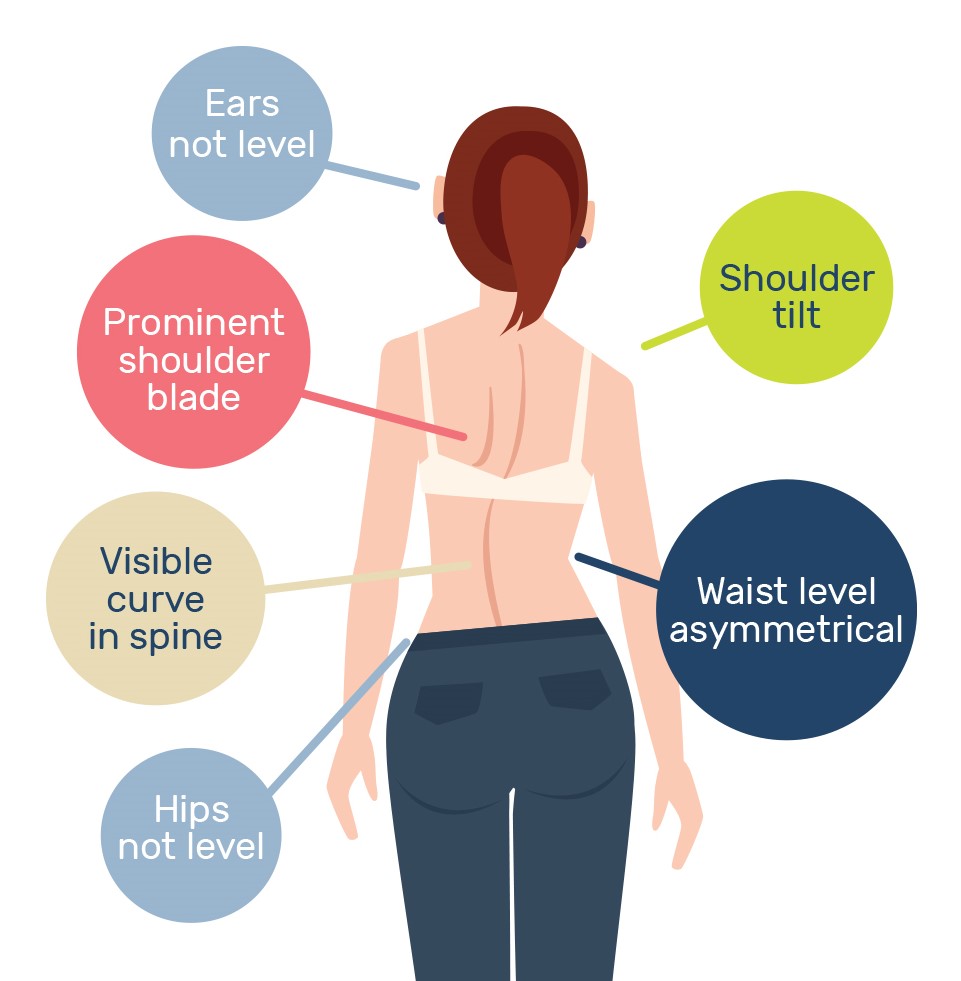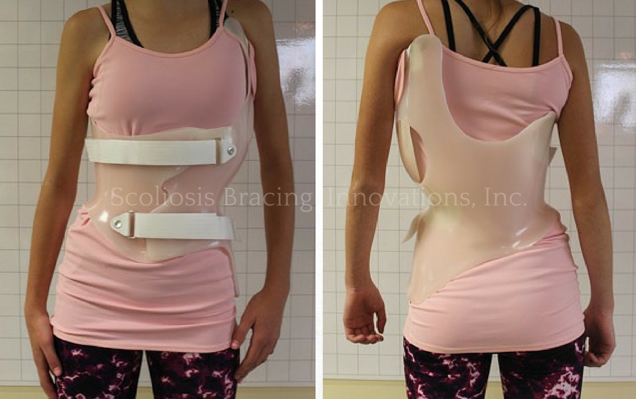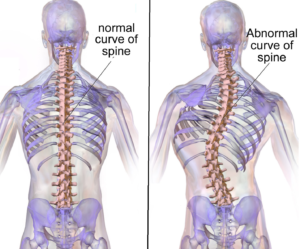Have you noticed that one shoulder sits higher than the other? Do you find you tend to always lean to one side? Or maybe you’ve noticed that your waist looks fuller on one side, and that your clothes fit a bit funny. You may have something called scoliosis, which is an abnormal curvature of the spine. It can lead to back pain, hip pain, difficulty breathing, poorly fitting clothes, and in some cases, nerve impingement and nerve pain. Read on to learn more.
What Is Scoliosis(1,3)
Scoliosis is a 3D deformation of the spine, which leads to visible changes in the appearance of the torso, and internal structural changes in the intervertebral discs in the back. If left untreated, this eventually leads to irreversible changes in the structure of the bones in the back as well. Depending on the severity of the scoliosis, it may or may not be painful until later adulthood. Typically, most of the structural changes occur during adolescence before the bones are finished growing. Once skeletal maturity is reached – when there can be no more change in bone structure – the curve will remain at that shape. However, later on in adulthood, we can start to experience age-related changes to the bone that can lead to worsening of this curve as time, and age, goes on.
Progression of Scoliosis(1,3)
In adolescence or early stages, scoliosis can be painless, and can often be missed if it is mild. If left untreated and allowed to progress, scoliosis can cause an aching back pain, which typically feels like the muscles on one side of the back are constantly tight. As the scoliosis progresses, you can begin to develop breathing challenges, as the ribcage will be more compressed on one side of the body, making it difficult to take in a full breath. Sometimes, the bottom-most rib can even touch the top of the hip bone on one side which can lead to sharp, acute pain. Over time, the intervertebral discs can become wedged-shaped which can cause nerve complications such as numbness and tingling, nerve pain, and nerve root compression.
What Causes Scoliosis?(1)
80-90% of scoliosis cases are idiopathic – which means there is no known cause. Adolescent Idiopathic Scoliosis is the most common type of scoliosis, affecting adolescents aged 9-17, and typically affects girls more than boys. The remaining 10-20% of scoliosis causes are due to congenital abnormalities (from birth), neuropathic or neuro-muscular conditions, or other systemic diseases.

Because of this sequelae, early detection and treatment is essential to maintaining a quality of life that is not dictated by the scoliosis!
How Can I Check if I Have Scoliosis?(1)
Perform this quick checklist to see if you may have scoliosis:
-
- Is one shoulder or shoulder blade higher than the other?
-
- Is one arm farther away from the body?
-
- Does your body look tilted to one side?
-
- Are your hips uneven in height or twisted?
-
- Is one leg shorter than the other?
-
- Do you find it hard to take a full deep breath?
-
- When exercising, do some moves feel easier on one side of the body?
-
- Do you have consistent achy pain on one side of the upper or lower back only?
-
- Is there a hump on one side of your back when you bend forward?
-
- Do your lower ribs stick out in front on one side of your body?
-
- Does one foot turn in/out more than the other?

If you answer yes to one or more of these questions, you would benefit from a physiotherapy assessment to determine whether you have scoliosis.
A physiotherapist will also be able to help figure out whether your scoliosis is functional or structural.
If you have functional scoliosis, you may answer yes to some of the screening questions above and appear to have a curvature, however on x-ray, the spine remains straight. That is because functional scoliosis is due to muscle imbalances and postural habits, rather than the structure of the spine itself. For this reason, this type of scoliosis responds very well to orthopaedic physiotherapy treatments.
Structural scoliosis involves visible changes to the vertebrae on x-ray, and the shape of the spine is physically deformed. Physiotherapy treatments are also very beneficial for structural scoliosis, however depending on the severity, you may also require bracing and/or surgery.
Treatment of Scoliosis
1. Physiotherapy (1,3)
Traditional Orthopaedic Physiotherapy treatment typically consists of core stabilization exercises combined with appropriate back strengthening. The goal is to stretch the tight muscles on the inside of the curve, and strengthen the elongated muscles of the outside of the curve, while also working on the deep core unit to provide overall stability to the whole body. An exercise program will be developed based on your symptoms, and will aim to address areas of pain and stiffness that you are experiencing.
Schroth Therapy is a specific exercise-based approach to treating scoliosis and other postural dysfunctions. The exercises combine postural corrections with breathing mechanics to work towards curve correction. The overall aim of Schroth therapy is to improve motor control of the body and essentially ‘re-learning’ where straight is. When the scoliosis is detected early, and rapid intervention with Schroth is implemented, correction of the abnormal spine curvatures towards a more normal postural alignment is possible.
2. Bracing (1,2,3)
Depending on the severity of your curve on x-ray, an orthopaedic surgeon who specializes in scoliosis may recommend a full body brace. Sometimes, this can result in a slight straightening of the curve, however this is not the primary goal. The brace is typically worn until skeletal maturity has been achieved, and works to prevent further progression of the scoliosis curves. They are typically prescribed to be worn full time (up to 23 hours per day), and work to provide counter-pressure on the outside of the curves while offloading the fatigued muscles on the inside of the curves.

3. Surgery (2)
If or when scoliosis progresses, it can begin to cause compression of the spinal cord. If it does not respond to more conservative treatments (physiotherapy, exercise and bracing), surgery may be required. The surgery would aim to stop curve progression, reduce the deformity, and maintain/regain balance through the trunk. Surgery typically involves spinal fusion where the bones of the spine are fused with hardware to secure the spine in a straightened position. There are also some newer approaches to scoliosis correction surgery that do not involve fusion, but rather are based on pressure/counter-pressure systems, pulleys, and tethers to gradually straighten the spine.
5 FAQ’s about Scoliosis
1. I have scoliosis, will I have to have spinal surgery?
No! The need for surgery is based on the severity of the curve(s), how much it is impacting your daily life, and how you have responded to non-surgical treatment approaches. Having scoliosis does not necessarily mean you have to have surgery.
2. Will my scoliosis just keep getting worse?
Not necessarily. Once skeletal maturity has been reached, the structural component (the bones visible on x-ray) will not worsen until later adulthood, and even then it is not inevitable. It can appear to worsen due to muscle imbalances, depending on habitual postures, exercise habits, workplace ergonomics, etc. This is where a physiotherapy exercise based approach can be VERY helpful!
3. I was told to just “wait and see” what my scoliosis does before treating it. How long should I wait before seeking treatment for my scoliosis?
The ‘wait and see’ approach is an outdated approach to scoliosis management that we now know is not the way to go. The faster you get treatment, the better your chances are of stopping or slowing the curve progression, and avoid worsening symptoms.
4. Does swimming help manage my scoliosis?
Unfortunately, no. Although swimming is a great exercise for overall health and wellness, it can actually accelerate the progression of the curve, as it encourages the flattening of the thoracic spine. Historically, it was recommended as the “best” exercise for patients with scoliosis, as being in the water eliminates the force of gravity. Originally, it was thought that gravity played a role in scoliosis curve progression. However, we now know that this is untrue and have since advanced our treatment protocols for the condition such as the Schroth method outlined above. This is not to say that people with scoliosis should not swim recreationally, however competitive levels or very frequent participation should be avoided.
5. Does scoliosis only affect females?
Although more common in girls, boys can and do get scoliosis as well. Research shows there is a slightly higher prevalence of scoliosis in gymnasts and ballerinas/dancers, which are historically more female-dominant sports. This is more due to the overuse of one side of the body, or putting the body into positions that promote a flatter spine, rather than having more females in the sports.
What Next?
If you suspect you might have scoliosis, or you have already been diagnosed with scoliosis, check in with a physiotherapist for a spine assessment! Even if you currently don’t have any pain, the sooner you start treatment, the better chance you’ll have to stop the curve progression, avoid more serious symptoms, and potentially decrease the severity of the curve. The Peak Health physiotherapist will be able to assess whether you have functional or structural scoliosis, however, requesting full spine x-rays from your doctor would also be beneficial to get a good look at the true shape of the spine. If you would like to pursue Schroth therapy, an x-ray prior to the assessment is mandatory, as the physiotherapist will need to examine the x-ray images before you attend.
References:
- Negrini, S., Donzelli, S., Aulisa, A.G. et al. 2016 SOSORT guidelines: orthopaedic and rehabilitation treatment of idiopathic scoliosis during growth. Scoliosis 13, 3 (2018). https://doi.org/10.1186/s13013-017-0145-8
- American Association of Neurological Surgeons (n.d.). Scoliosis. https://www.aans.org/Patients/Neurosurgical-Conditions-and-Treatments/Scoliosis#:~:text=Scoliosis%20affects%202%2D3%20percent,occurring%20equally%20among%20both%20genders.
- UK Scoliosis Clinic (n.d.). What is Scoliosis?. https://scoliosisclinic.co.uk/what-is-scoliosis/.
